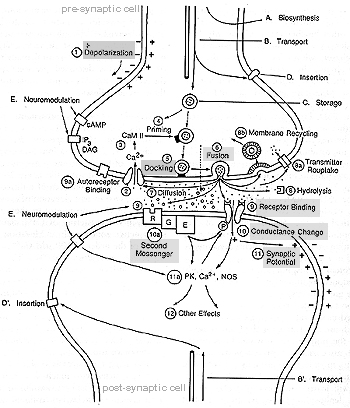Date: Tue Dec 19 09:35:49 2000
Posted By: Alexander Craig, Grad student, Physiology/Neurobiology
Area of science: Neuroscience
ID: 976126378.Ns
Message:
I assume you want to know about what happens after an action potential has
reached the synapse.
I will start off with a short - but somewhat simplified -recap of how a
synapse is schematically structured although you probably already know
that:
You have the pre-synaptic cell which usually ends in a so called terminal
bouton and 'sends' the chemical signal. In close apposition you find the
post-synaptic cell which receives the neurotransmitter signal. Both are
separated by a synaptic cleft usually in the range of 25 to 100 nm in
width.
When there is no specific signal, the membranes of both pre- and
post-synaptic cell are at their resting potential (for simplicity's sake we
will neglect the fact that sometimes spontaneous action potentials arrive
at the synapse), which is essentially determined by the conductance for
different ions (sodium, potassium, chloride) according to the Nernst
equation.
So, here's our cell - resting - and what happens at the synapse when the
action potential comes rushing in is, briefly, the following:
- The presynaptic membrane depolarizes.
- This in turn leads to the opening of voltage sensitive calcium
channels resulting in calcium influx.
- Calcium binding to different proteins of the exocytosis
apparatus has the effect that the synaptic vesicles - already being
ready for release (at least according to one model) - dock to and then fuse
with the presynaptic membrane.
- This sets free the neurotransmitter or other transmitter substance
contained within the vesicle.
- The transmitter diffuses across the synaptic cleft and binds to its
receptor on the postsynaptic cells (never mind the autoreceptors on
the presynaptic membrane which are involved in regulating neurotransmitter
production, storage, etc.).
- Upon binding the neurotransmitter will elicit one or another response
in the receptor, usually some conformational change which affects its ion
permeability, coupling to other proteins, or the like.
- But, alas, that's not all: while passing through the synaptic cleft
some of the neurotransmitter is 'lost' either because it's being
degraded by specific enzymes (recall for example acetylcholine
esterase) or is being sequestered by re-uptake transporters removing
it from the cleft back into the presynaptic cell where it is being
reutilized. Or it binds to autoreceptors which basically are like
neurotransmitter receptors except that they reside on the presynaptic
membrane.
- Activation of the receptor leads to various intracellular responses,
e.g.. activation or inhibition of G-proteins, second messenger production,
changes in protein kinase activity, NO-synthesis, etc., and very important
propagation of an electrical signal in the post-synaptic cell, the
so-called synaptic potential (not an action potential - yet!).

Image summarizing the events at the synapse; taken from the textbook by
Shepherd
with some additions by me.
G = G-protein, E = effector, PK = protein kinase
For further questions feel free to email me at this address.
Glossary
-
Autoreceptor: receptor for a substance on the same cell that
releases that transmitter; autoreceptors usually play a role in feed-back
regulation of transmitter production, etc.
-
Conductance (measured in Siemens): inverse of the resistance R;
proportional to permeability, describing a membrane's tendency to let
certain ions pass through it, usually via more or less specific ion
channels.
-
Exocytosis apparatus: a group of proteins, some of them associated
with either the vesicle membrane or the presynaptic membrane, others
residing in the cytosol of the presynaptic cell (e.g. interacting with the
cytoskeleton), forming a complex regulating the docking and fusion of
synaptic vesicles with the cell membrane of the presynaptic neuron. Calcium
sensitive proteins integrate the calcium signal that triggers exocytosis.
-
NO: nitric oxide, a gaseous second messenger liberated from the
amino acid arginine by the enzymatic action of nitric oxide synthase;
believed to play a role as a retrograde messenger, i.e. a transmitter
substance being sent from the postsynaptic cell to the pre-synaptic cell.
References
Current Queue |
Current Queue for Neuroscience |
Neuroscience archives
Try the links in the MadSci Library for more information on Neuroscience.
MadSci Home | Information |
Search |
Random Knowledge Generator |
MadSci Archives |
Mad Library | MAD Labs |
MAD FAQs |
Ask a ? |
Join Us! |
Help Support MadSci
MadSci Network,
webadmin@www.madsci.org
© 1995-2000. All rights reserved.
